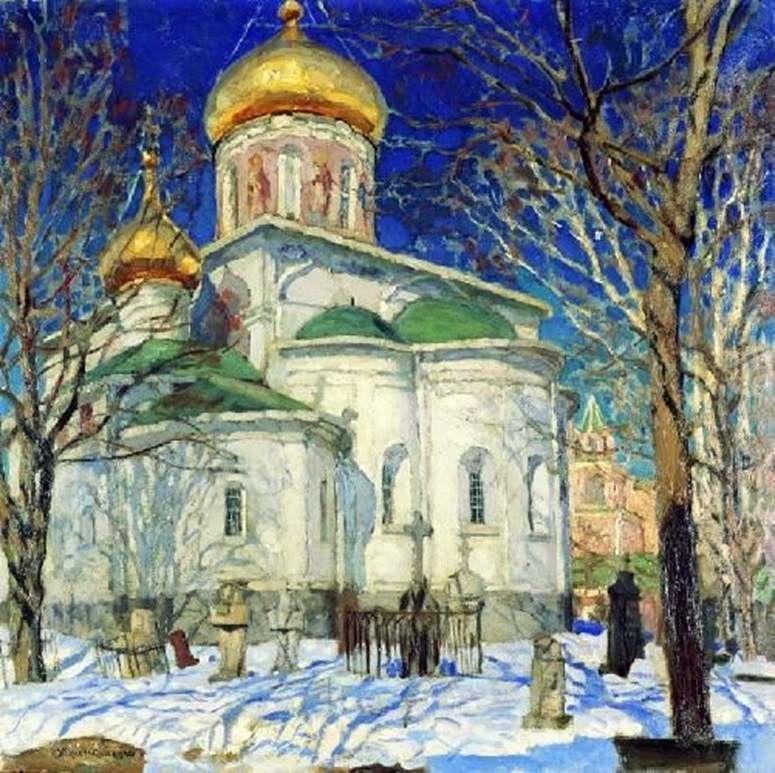
Russian landscape of the turn of the XIX-XX centuries in the work of the Wanderers received two lines of development. One was connected with the academic direction of the landscape landscape and was distinguished by the dryness and smoothness of the letter, the other branch that followed the Levitan, Savrasov, Polenov picked up artists of the younger generation – Turzhansky, Petrovichev, Vinogradov, professed the lyric-philosophical landscape. This line was marked by a sensitive transmission in the images of nature of the emotional experiences of the “soul of nature itself”. Over time, the above-named young artists joined the Union of Russian Artists.
Among them was Stanislav Yulianovich Zhukovsky. His painting “The Church of the Nativity of the Virgin.” Zvenigorod “, written in 1904 in the Savvino-Storozhevsky Monastery near Zvenigorod, continues the thematic series of architectural landscapes of monasteries and cemeteries, started by the painter in the second half of the 1890s. For the work of Zhukovsky is characterized by the combination of works in the series, in each of which the plot-related composition is varied.
The leading beginning in the painting depicting the Zvenigorod Church of the Nativity of the Virgin is the transfer of the poetic charm of the unity of ancient Russian architecture and nature. Early spring. The sun casts bright burning flares on the golden domes of the white-stone cathedral and leaves deep blue shadows on the March snow. And, in spite of the fact that there is a churchyard near the church, there is not a shadow of sadness in the picture, and in the landscape there is a special grace that is peculiar to holy places. In search of the most expressive pictorial techniques, the artist wrote a tangle of branches of naked trees with fast, accurate strokes of the brush, and modeled the white surfaces of the temple with a broad textured stroke that goes into painting with relief molding on domes; even more loaded with glare spots.
The master turned to the corpus letter style, that is, he used powerful layers and paint bays, small strokes laid with a fine brush, combined with the work of a palette knife. Using large planes of white, blue colors, the author attached a decorative sound to the work, which most fully corresponded to the nature of the depicted moment. Stanislav Zhukovsky could write only from nature, and only the motive that captured him entirely, which corresponded to his inner essence. He wrote very quickly. The picture is even large, as contemporaries say, it took five or six sessions. Working, the artist did not like to be distracted, cherishing time and hurrying to fix those precious moments of illumination, the recreation of which was the strongest side of his work.
 Église de la Nativité de la Vierge. Zvenigorod – Stanislav Zhukovsky
Église de la Nativité de la Vierge. Zvenigorod – Stanislav Zhukovsky Iglesia de la Natividad de la Virgen. Zvenigorod – Stanislav Zhukovsky
Iglesia de la Natividad de la Virgen. Zvenigorod – Stanislav Zhukovsky Autumn (By the pond) by Stanislav Zhukovsky
Autumn (By the pond) by Stanislav Zhukovsky July Night by Stanislav Zhukovsky
July Night by Stanislav Zhukovsky Abandoned terrace by Stanislav Zhukovsky
Abandoned terrace by Stanislav Zhukovsky Joyful May by Stanislav Zhukovsky
Joyful May by Stanislav Zhukovsky Autumn. Veranda by Stanislav Zhukovsky
Autumn. Veranda by Stanislav Zhukovsky In front of the terrace by Stanislav Zhukovsky
In front of the terrace by Stanislav Zhukovsky